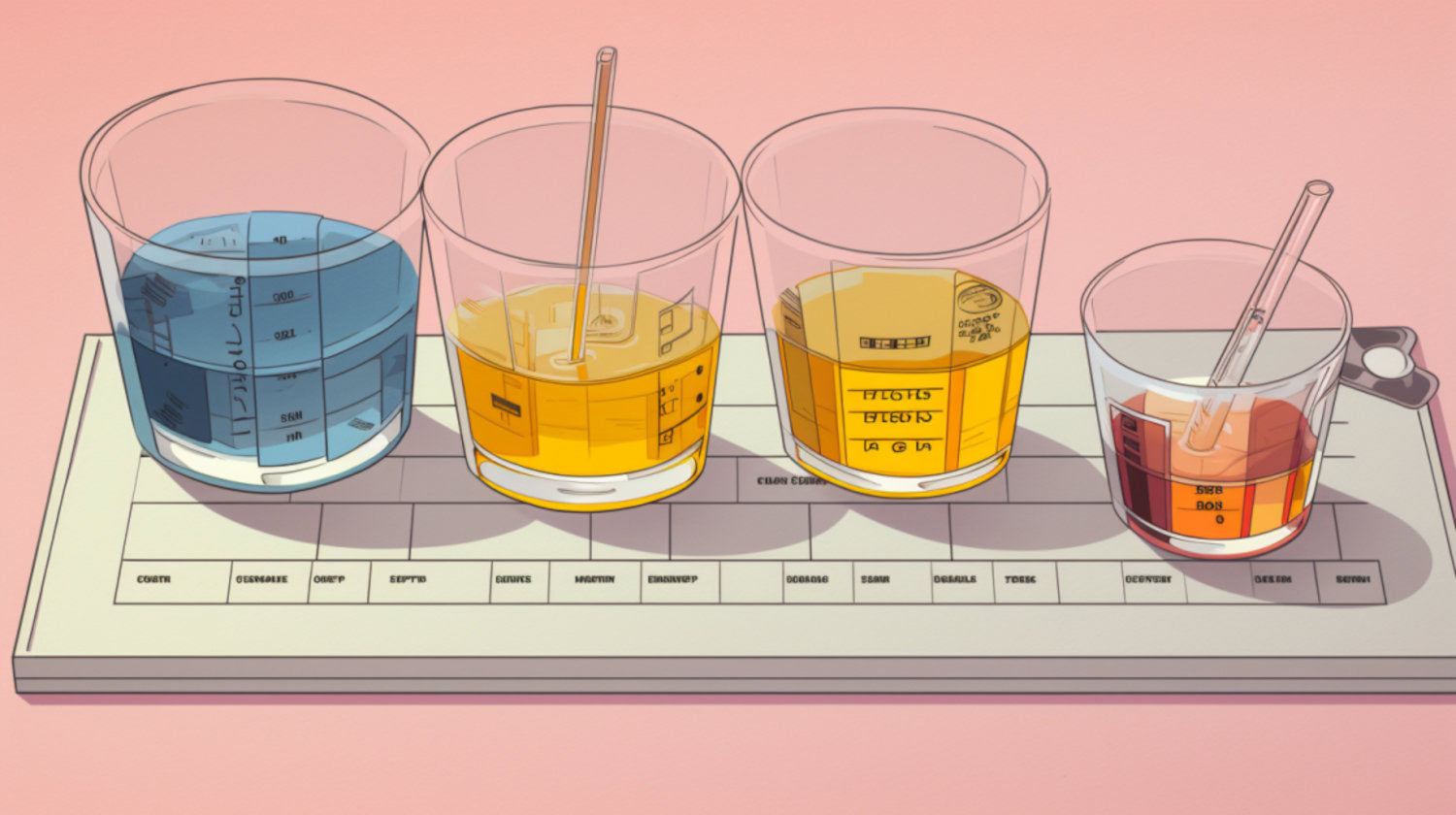The market for at-home drug testing is reaching its pinnacle, with numerous employers testing their employees for tetrahydrocannabinol (THC) and other federally illegal substances amid an influx of legal cannabis products. The use of at-home drug tests is reported to grow from USD 683.29 million in 2023 to USD 886.28 million by 2028. Even with all these tests being taken it's natural to wonder: How accurate are at home drug tests?
People may choose to test themselves for drugs at home as a way of preparing for a looming mandatory workplace drug test, as a follow-up to ensure sobriety, or to ensure that no conflicting substances are in the system before consuming a new type of medication. Some are sensitive enough to detect even the slightest trace of THC, which, as per the USDA Farm Bill of 2018, is legal to the amount of 0.3% in cannabidiol (CBD) products.
At-home THC testing products are less accurate than lab tests and may be more complex when it comes to detecting multiple substances. A home drug test may be able to confirm the presence of one or multiple prescription or illegal drugs, including amphetamines, antidepressants, benzodiazepines, barbiturates, cannabis, cocaine, ecstasy, opiates, methamphetamine, methadone, oxycodone, and PCP.
What are At-Home Drug Tests, and How Do They Work?
Drug tests focus on detecting metabolites created by the human body by pretty much anything that enters the system. Regardless of which type of at-home test you purchase, it triggers a positive reading by analyzing bodily fluids or substances to reveal the presence of those metabolites. Different types of drugs produce unique metabolites, most of which are detectable with at-home kits and laboratory drug tests.
The majority of drug metabolites are traceable for a few days after the last use, and with cannabis, elimination depends on the following factors:
- Frequency of Use - Cannabis metabolites are a byproduct of how the body uses the plant’s active chemicals. Frequent and heavy cannabis consumption means more metabolites setting up camp temporarily in your system.
- Body Fat Percentage - THC is lipophilic, meaning that it clings onto fat once inside the body. That said, if you have a high body fat percentage, THC will take longer to leave the body.
- Potency and Dosage - It goes without saying that the stronger the cannabis and the more you consume, the more metabolites will remain in your system.
An at-home THC test will always come with a list of instructions, so make sure you follow them if you want to get the most accurate results. Reading the labels before buying is a good way of determining whether that specific test is for you since there are various options on the market, including blood tests, hair tests, saliva/oral fluid tests, and urine tests.
According to the Food and Drug Administration (FDA), at-home drug testing kits are highly sensitive to drugs contained in urine. Tests will almost always return a preliminary (or presumptive) positive result if the drug(s) you test for is present in your system within the detectable limit. The FDA advises getting a second opinion after carrying out an at-home THC test (or any other type of over-the-counter drug test) by sending a urine sample to a reputable laboratory.
"It is very important to send the urine sample to the laboratory to confirm a positive at-home result because certain foods, food supplements, beverages, or medicines can affect the results of at-home tests. Laboratory tests are the most reliable way to confirm drugs of abuse," reads an official statement on the FDA website.
Types of At-Home Drug Tests

Supermarket store shelves and pharmacy cabinets are stacked with a broad range of at-home cannabis drug tests, including five-panel drug tests and 14-panel home drug tests. Regardless of how many substances you test for, there are four main ways to identify drugs in the system:
- Saliva/Oral Fluid Tests - This type of home cannabis drug test has the shortest window of detection of 5-48 hours. Because of this, a saliva/oral fluid test is not as popular as the other tests featured on this list.
- Urine Tests - These are easily some of the most common drug tests. Not only is the window of detection longer than saliva/oral tests, but urine tests are also more accurate.
- Hair Tests – Hair home drug testing kits for cannabis consumers may uncover a long history of drug use since drugs in hair are detectable for up to 90 days. This means that a cannabis consumer who abstains from the plant for one month will likely still test positive for THC if the cannabis product contains traces of THC (such as a full-spectrum CBD product). External contaminants, such as dust, may cause difficulty interpreting the results.
- Blood Tests - Just minutes after ingesting cannabis, a consumer may test positive for a THC blood test. These types of at-home drug tests have a similar window of detection as saliva/oral fluid tests, with the maximum window being around three days. Chronic cannabis consumers may struggle to pass a blood test since the metabolites can take longer to leave the system.
Are Home Drug Tests Accurate?
So long as you understand how accurate at-home drug tests are, you can better anticipate a potential false positive or vice-versa. The FDA claims no at-home drug test is 100% accurate, and numerous factors may tweak the results. Depending on the environment, the individual who is being tested, and the quality of the kit, accuracy fluctuates from one subject to another.
Some additional factors that must be taken into account when testing for cannabis include:
- Brand and type of drug test
- How many drugs are being tested for
- Delays between drug consumption and testing time
- Presence of other substances
- Test exposure to contaminants
- How old the test is
One study exploring the reliability of at-home THC tests found that all tests have "intrinsic limitations, and errors are inevitable." The main goal was to find the most cost-efficient and (accurate) test for discerning whether or not drivers operate their vehicles under the influence of drugs. In addition to testing for THC, the researchers used OTC drug kits to detect cocaine metabolites (COC) and opiates (OPI).”
"On-site kit sensitivity ranged from 82.9% to 100% for THC, 82.5% to 100% for COC, and all were at 100% for OPI," wrote the researchers, suggesting that consumers can rely on out-of-laboratory testing for cannabis detection purposes.1
The findings of this study are particularly important for the organizers of mass screening programs since the smallest margin of error can be colossal when representing large numbers of people. False positives are usually triggered by certain types of medication, such as Phentermine weight loss pills, poppy seeds, and alcohol-based mouthwash, depending on what's being tested for.
Consumers should pay extra attention to the detection window of certain drugs since this can drastically affect the results. Take cocaine, for example, which is detectable in urine for 2-6 hours after use but may be present in the system for 2-3 days. Even second-hand cannabis smoke could trigger a positive OTC drug test if the individual were recently exposed before the test took place.
Home Drug Tests vs. Lab Testing

An immunoassay (IA) is perhaps the most common type of drug test used in both home and laboratory settings. It utilizes antibodies to detect drug metabolites.2 The most frequently used IA drug test panel features the “SAMHSA-5” - a typical panel established under the Drug-Free Workplace Act during the 1980s. It tests for substances like amphetamines, cocaine metabolites, THC, opiates (such as heroin, morphine, and codeine), and phencyclidine (PCP). The SAMHSA-5 does not test for synthetic opiates (like buprenorphine, hydrocodone, oxycodone, or methadone), but some panels are sensitive to benzodiazepines and barbiturates.3
Deciding between a home drug test and a lab test can be overwhelming, particularly when pressed for time. In this case, at-home testing is the way to go since you can get the results on the same day, whereas lab testing may take weeks. It’s also worth considering the reason(s) why you require a cannabis drug test. While home drug tests may be somewhat accurate, due to the intelligence of the equipment used in laboratory settings and the professionals who work there, laboratory tests almost always come out on top. Unexpected or invalid results may be further tested using laboratory chromatography.
Certain scenarios are more critical than others; therefore, accuracy is key; if you have time, consider an at-home drug test and a home detox before getting an official lab test to ensure the result is all-clear. Let’s dabble in some potential uses for drug testing:
- Athletic Testing - Athletes and sports professionals must abide by strict drug rules, particularly those who compete in championships and other contests. Testing ensures that all athletes are in good physical shape. A positive drug test may result in disqualification.
- Medical Testing - Biological drug test samples serve as critical building blocks for nurses and doctors to determine proper treatment options for their patients, e.g., to avoid prescribing interfering medications.
- Legal Testing - If you drive after smoking cannabis, you run the risk of getting charged with a DUI. In this case, law enforcement officials will carry out legal testing. Legal drug testing may also be required if a crime is committed and the felon is believed to be under the influence of drugs.
- Substance Use Disorder - At-home drug tests are suitable for diagnosing, treating, and monitoring people with cannabis use disorder. Regular screening can help substance use disorder professionals track treatment adherence, assess abstinence, and identify early relapse.
- Employment Screening - Employers may necessitate a drug screening to determine if someone is a reliable and healthy candidate for the role. Since some employers require periodic or random drug testing, it may be important to conduct at-home drug testing regularly. Workplace drug testing may also take place if the employee is suspected of using drugs or prohibited substances in the workplace.
How to Ensure the Accuracy of At-Home Drug Tests
An over-the-counter drug (OTC) test won’t necessarily be any less accurate than a lab drug test. These easy-to-use products make it possible to detect a positive result before an official lab test, which may be crucial if you are awaiting an employment drug screening or something similar.
According to the FDA, numerous things can influence drug test accuracy, including the way the test is done, how it is stored, what (if any) prescription or OTC meds were used prior to the test’s completion, and what alternative substances, foods, and drinks the person consumed.
Despite the accessibility and privacy associated with at-home drug testing, they can return botched results if you fail to contemplate external factors beforehand. Ask yourself the following questions to ensure optimum accuracy when trying to figure out if THC or CBD shows up on a drug test:
- Was the sample taken during the window of detection?
- Did any contaminants come into contact with the test?
- Are there any other substances or medications present in the system that may impact the test outcome?
- Was the test exposed to colder or hotter temperatures than mentioned in the storage instructions?
- Did you use a transdermal product or cream designed to penetrate the bloodstream?
Don’t get too excited if an expired over-the-counter drug test reveals a negative for cannabis consumption (or other substances that you may be testing for). This is a common occurrence caused by inactive test detection chemicals. False negatives may also surface if the test has been damaged or is faulty.
If you have already researched some basic info about how long cannabinoids like CBD stay in your system, you can avoid a false negative or positive. Preparing for an at-home drug test is absolutely vital if you want to pass. Ridding your body of cannabinoid metabolites is achievable through home detoxing, water flushing, exercise, and metabolism-boosting practices, such as eating a high-protein diet and getting plenty of sleep.
Does Passing a Home Test Mean You'll Pass a Lab Test?

Whether you are intent on passing a pre-employment assessment after a weekend of green indulgence, are eagerly anticipating acceptance into a strictly drug-free sports academy, or are impatiently waiting to be released from a substance use disorder clinic, chances are you'll need to undergo a drug test.
Instead of pondering over the thought of potentially failing or passing an official drug test, put your mind at ease by purchasing one of the many home drug testing kits on the market. Keep in mind that negative results do not guarantee that the tested person did not consume drugs. However, at-home kits provide general guidelines and convenience for the tested people.
Spend some time researching drug-testing brands before buying a DIY kit. It's also worth researching the contact information of a nearby laboratory that you can trust to confirm the presence or absence of drug metabolites.
References
- Buchan BJ, Walsh JM, Leaverton PE. Evaluation of the accuracy of on-site multi-analyte drug testing devices in the determination of the prevalence of illicit drugs in drivers. Journal of Forensic Sciences. 1998;43(2):395-399. https://pubmed.ncbi.nlm.nih.gov/9544550/ ↩︎
- Raouf M, Bettinger JJ, Fudin J. A Practical Guide to Urine Drug Monitoring. Federal Practitioner. 2018;35(4):38-44. https://www.ncbi.nlm.nih.gov/pmc/articles/PMC6368048/ ↩︎
- Hadland SE, Levy S. Objective Testing. Child and Adolescent Psychiatric Clinics of North America. 2016;25(3):549-565. doi:https://doi.org/10.1016/j.chc.2016.02.005 ↩︎
The information in this article and any included images or charts are for educational purposes only. This information is neither a substitute for, nor does it replace, professional legal advice or medical advice, diagnosis, or treatment. If you have any concerns or questions about laws, regulations, or your health, you should always consult with an attorney, physician or other licensed professional.




